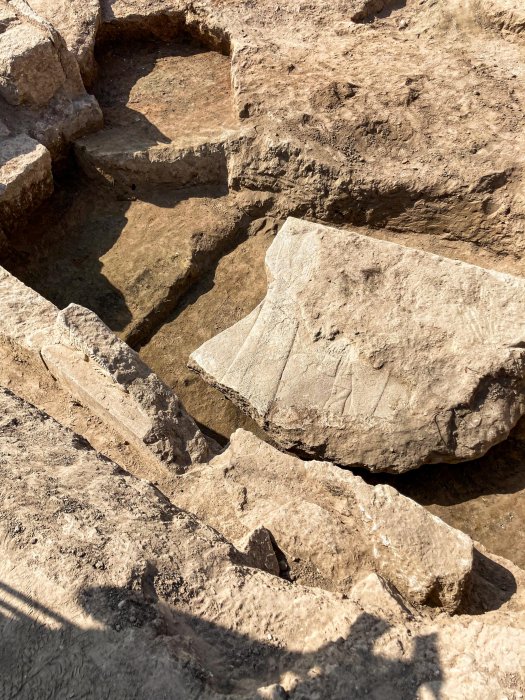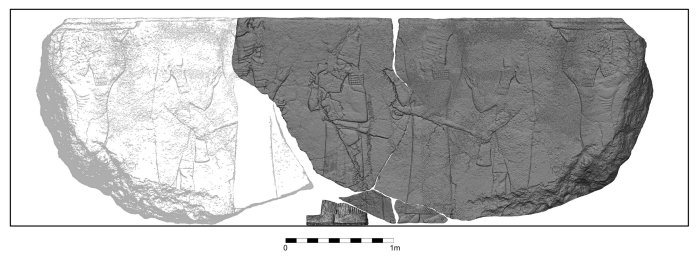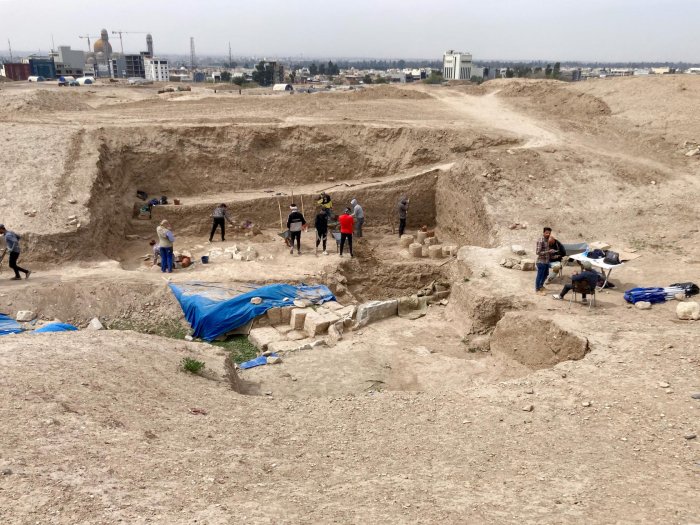Jan Bartek – AncientPages.com – Archaeologists working in Iraq have made a remarkable discovery in the throne room of King Ashurbanipal’s North Palace in the ancient city of Nineveh. They uncovered significant portions of a monumental relief depicting the seventh-century BC Assyrian ruler alongside two major deities and other figures.
Fragment of the discovered relief. Credit: Aaron Schmitt
A team from Heidelberg University in Germany achieved this finding. The relief, carved on an enormous stone slab measuring 5.5 meters long and three meters high, weighs approximately 12 tons. According to Prof. Dr Aaron Schmitt, head of the excavations, its significance lies not only in its size but also in its unique depiction of major deities, which is unprecedented among known Assyrian palace reliefs.
Nineveh, near modern-day Mosul in Iraq, was one of North Mesopotamia’s most important cities and became the capital of the Assyrian empire under King Sennacherib in the late eighth century BC.
3D model of the relief: The finds are marked in dark gray, the light gray part represents a reconstruction based on the finds. King Ashurbanipal is depicted in the center. Credit: Heidelberg University
Since 2022, Aaron Schmitt and his team have been exploring Kuyunjik mound within King Ashurbanipal’s North Palace as part of Heidelberg University’s Nineveh project initiated by Prof. Dr Stefan Maul from their Department of Languages and Cultures of the Near East back in 2018. British researchers first investigated this site at the end of the 19th century and discovered large-scale reliefs now displayed at London’s British Museum.
Excavations in the ancient city of Nineveh. Credit: Aaron Schmitt
The recently discovered relief features King Ashurbanipal, the last significant ruler of the Assyrian empire, prominently displayed at its center. He is accompanied by two major deities: Ashur and Ishtar, the patron goddess of Nineveh. Behind them stands a fish genius, symbolizing salvation and life for both the gods and the king, along with a figure with raised arms likely representing a scorpion-man. According to Aaron Schmitt, these elements indicate that a large winged sun disk was initially positioned above the relief.
The research team exploring the ancient site. Credit: Aaron Schmitt
The winged sun is a significant solar symbol in the Ancient Near East, representing divinity, royalty, and power. This emblem was commonly used to convey authority and divine protection across various cultures in the region.
In the upcoming months, researchers will use data collected on-site to conduct an in-depth analysis of the depiction and its archaeological context. Their findings will be published in a scientific journal.
See also: More Archaeology News
Professor Schmitt notes that this relief was initially situated in a niche opposite the main entrance to the throne room—the palace’s most significant area. The Heidelberg team found fragments of this relief buried in an earth-filled pit behind this niche, likely excavated during the Hellenistic period (3rd or 2nd century BCE). This burial might explain why British archaeologists missed it over a century ago.
Plans are underway to eventually restore and display this relief at its original location for public viewing in collaboration with Iraq’s State Board of Antiquities and Heritage (SBAH).
Written by Jan Bartek – AncientPages.com Staff Writer





